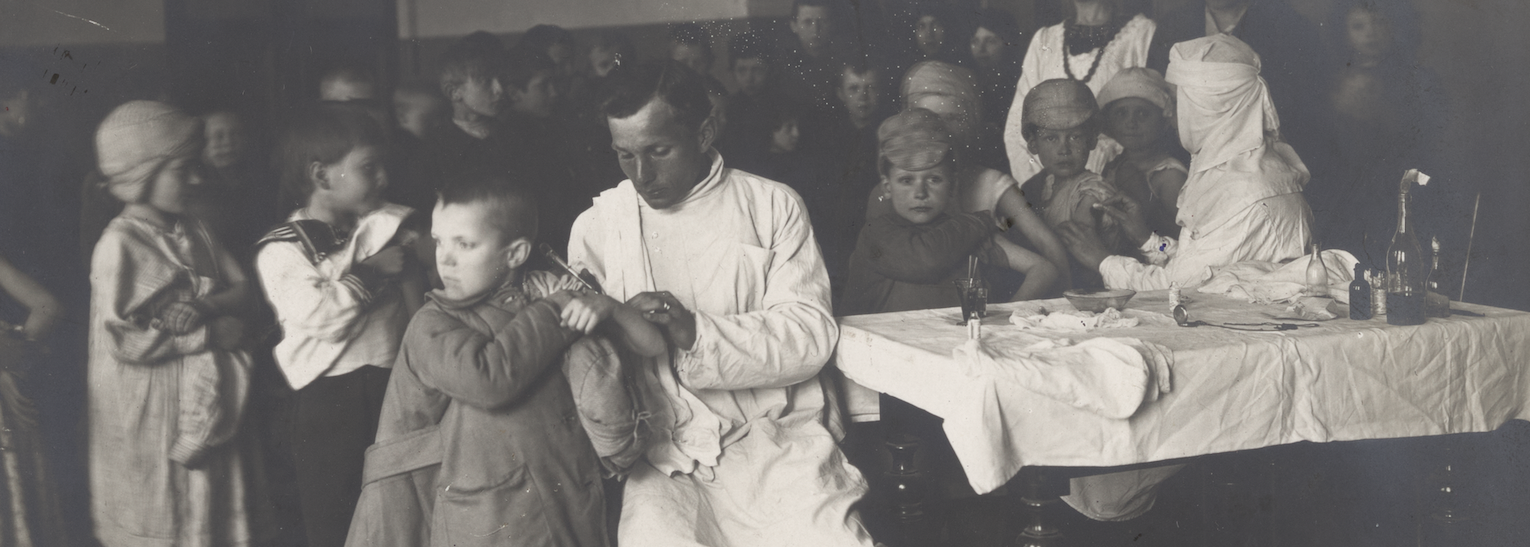Published: 06/19/2023
Lead photo: Inoculation of children with the tetra vaccine at the ARA kitchen on Gagarin Street in Petrograd, spring 1922. From the ARA Russian operational records, Hoover Institution Library & Archives
Interview by Jamie Hansen, Global Health Communications Manager

Global Health Faculty Fellow Bertrand M. Patenaude, PhD, studies the intersection of war, politics, humanitarian aid, and human health. As a lecturer in history, international relations, and human rights, his courses cover topics such as United Nations peacekeeping, genocide, famine in the modern world, and humanitarian aid.
Patenaude, also a research fellow at the Hoover Institution, is the award-winning author of numerous books on these topics, including The Big Show in Bololand. This book chronicles the American Relief Administration’s efforts, led by future U.S. President Herbert Hoover, to combat the effects of the devastating famine that descended on Soviet Russia and Ukraine in 1921 by delivering daily food and medicine to millions of citizens in Soviet Russia.
His new book, Bread + Medicine: American Famine Relief in Soviet Russia, 1921–1923, expands on that story by recounting the pivotal role that U.S. doctors and local medical teams played in saving lives by combatting and preventing devastating disease outbreaks during that time. They did this in part through widespread vaccination drives and sanitation efforts, all in conjunction with the provisioning of food. Co-authored by Joan Nabseth Stevenson, the book is a companion publication to the Hoover Institution Library & Archives’ exhibition of the same name and draws extensively from photos and records from the library’s archives.
Dr. Patenaude discussed the lessons this story holds for effective humanitarian aid and the crucial role medical relief plays in saving lives during a famine.
What made this humanitarian effort so successful, and what lessons can we learn from it?
Today, there’s a good deal of criticism about the mistakes made by many NGOs in dealing with humanitarian crises. One author referred to this in the title of a book as The Crisis Caravan, where NGOs come upon the scene of a complex emergency, raise money off it, and then, once the worst is over, move on without having addressed the root causes of the crisis.
There’s no crisis caravan in the story of how the American Relief Administration (ARA) responded to the 1921–23 famine in Soviet Russia. When you look at the long-term difference the ARA was able to make, it’s absolutely amazing.
In studying humanitarian intervention over the years, I have come to see how crucial the medical program was to the success of the American relief mission a century ago. Yes, American food saved many lives, but the medical program was critical to the success of the mission. The essential point is that most people caught up in famine don’t die of outright starvation; they die of diseases caused by hunger and famine-related displacement.
At the same time, the American doctors who arrived in Soviet Russia in 1921 quickly realized that it was pointless to save people with medical treatments only for them to fall victim to starvation—so they made sure to deliver American food to every hospital they were supplying with medicine and medical equipment. Beyond that, Herbert Hoover, the chairman of the ARA, understood that ending the famine would require ensuring the success of the Soviet harvest of 1922. And so, in conjunction with the delivery of life-saving food and medicine, the ARA also organized the delivery of wheat seed from the American Midwest for planting in the Soviet heartland.
Six million people died in the famine. We don’t know how many lives were saved through the gifts of food, medicine, and seed, but I think we can reasonably assume it was many millions.
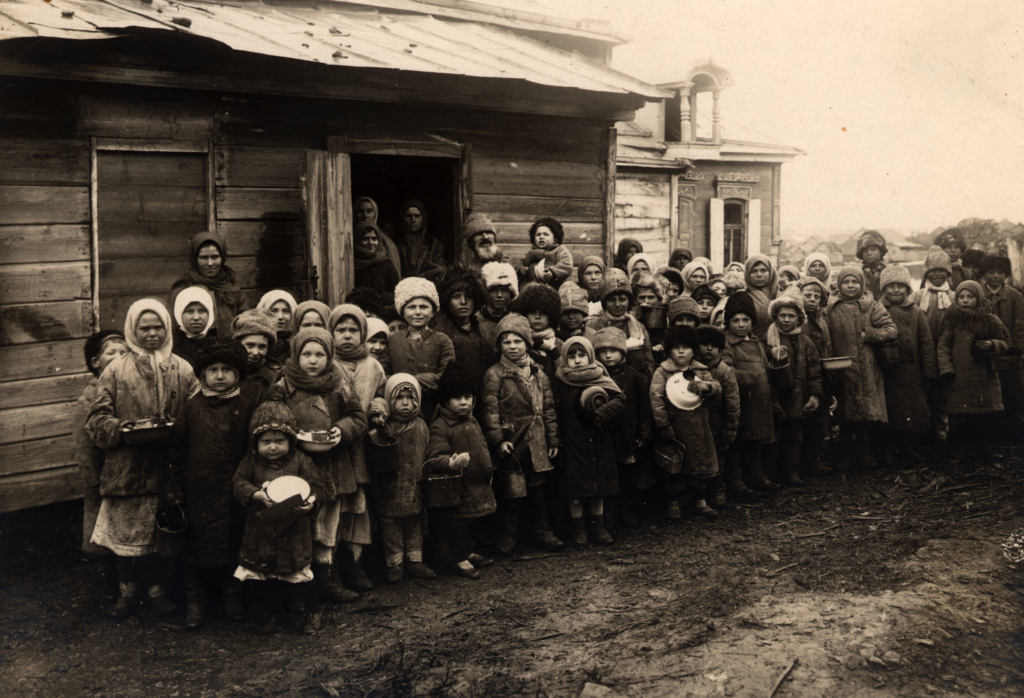
You describe how American doctors were inspired by the fortitude and ingenuity of Russian physicians working under extreme duress, and motivated by a sense of solidarity. How did their approach support and enhance, rather than supplant, Russian physicians’ efforts?
When the Americans with the ARA arrived in Russia, they were struck by the heroism of the local doctors who, like front-line soldiers, refused to abandon their posts despite the catastrophic conditions all around, including the fact that their ranks had been thinned by disease and malnutrition after years of civil war. They were soldiering on, despite having almost nothing in the way of essential medicines and medical supplies, including basic items such as bed linens, blankets, and bandages.
One American Red Cross doctor visiting Soviet Russia in the fall of 1922 wrote, “When I see what the doctors of this country have done, are doing now, and are going to try to do this winter, I am proud to be a doctor.”
The relatively small team of 30 American physicians joined the mission not to practice medicine, but to serve as administrators. They were truly doctors without borders in the sense that they collaborated with and empowered their fellow physicians and other healthcare workers on the scene. Given the enormous scale of the crisis, with the huge numbers of people involved across an immense landscape of death and disease, the relief mission could only have succeeded as a result of this remarkable collaboration.
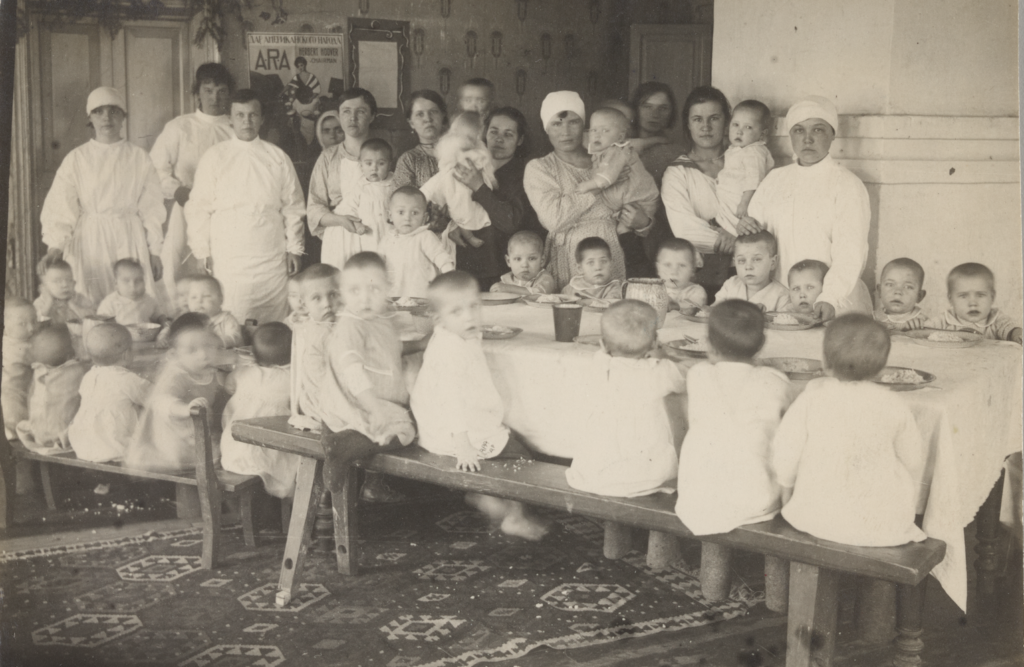
When displacement and famine combined to create fears of a typhus outbreak, how did modern medicine and famine relief avert a crisis?
Typhus was a special source of terror, in large part because there was no vaccine against this louse-borne disease, so absolutely everyone was vulnerable, including the American relief workers. Typhus was usually spread by war, but in this case the vector was a wave of refugees fleeing famine—many hundreds of thousands of ragged and vermin-ridden people desperately looking for food. The Americans of the ARA realized that in order to stop the spread of deadly typhus, as well as other contagious diseases, they would have to reverse the tide of refugees. In this they were greatly helped by the fact that they had leverage in the form of food. They were able to use the promise of food to persuade reluctant refugees to move into special barracks constructed especially for them where they were supplied soap for bathing and had their clothing disinfected. By the late spring of 1922, these displaced people were returning to their homes.
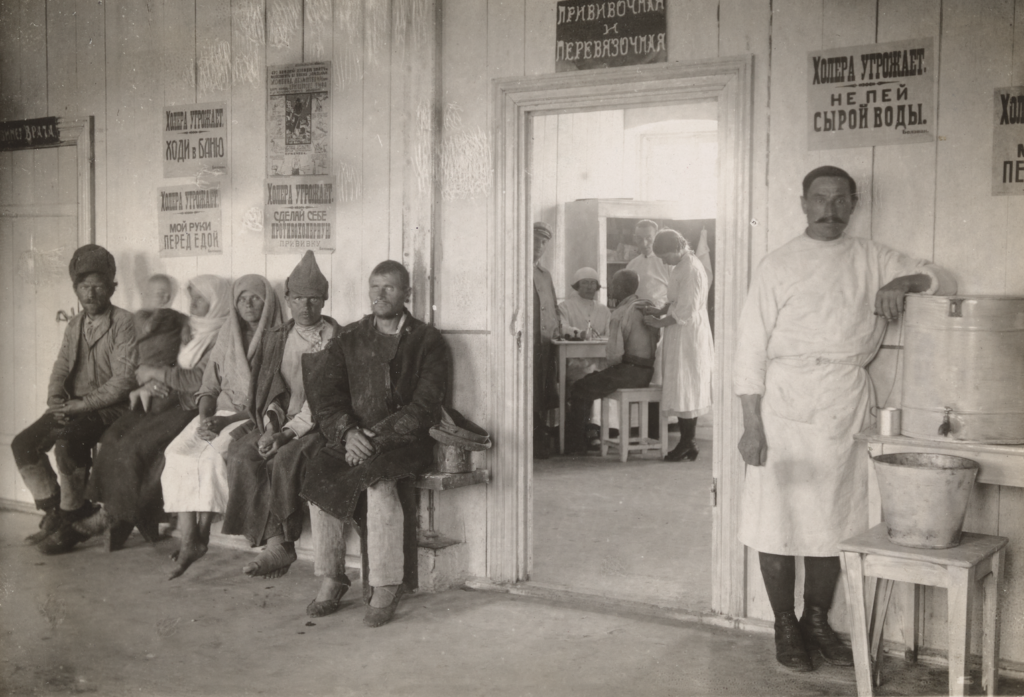
Vaccination, a cutting-edge tool at the time, was used to avert another potential health risk – cholera. How did physicians build trust and gain buy-in for this life-saving but novel intervention?
Just when the threat from typhus was abating as people shed their lice-infested clothing in the spring of 1922, a new threat emerged in the form of cholera, another epidemic disease that can prove devastating in a time of famine. Vaccination was the state-of-the-art prevention for cholera, but the Americans understood that many of their beneficiaries would likely be skeptical, if not outright fearful, of being inoculated. In fact, as these Americans discovered, there were even Russian physicians who needed to be brought around.
In order to minimize the ill-effects of such vaccine skepticism, Dr. Henry Beeuwkes, the head of the American medical program, decided to procure all ARA vaccines from the Pasteur Institute in Paris. He knew that local physicians held the Pasteur Institute in especially high regard and that this would boost the credibility of the vaccines and thus facilitate the vaccination campaign. Crates of vaccine supplies shipped from Paris were clearly labeled Institut Pasteur, seen by the Soviet medical establishment as the gold standard for infectious disease research.
Here again, the leverage provided by American food helped make the vaccination drive a success. Children being fed a daily meal by the ARA had to get vaccinated in order to continue eating at ARA kitchens. The same applied to the adults receiving the daily American corn ration. And refugees wishing to board a train had to show proof of vaccination.
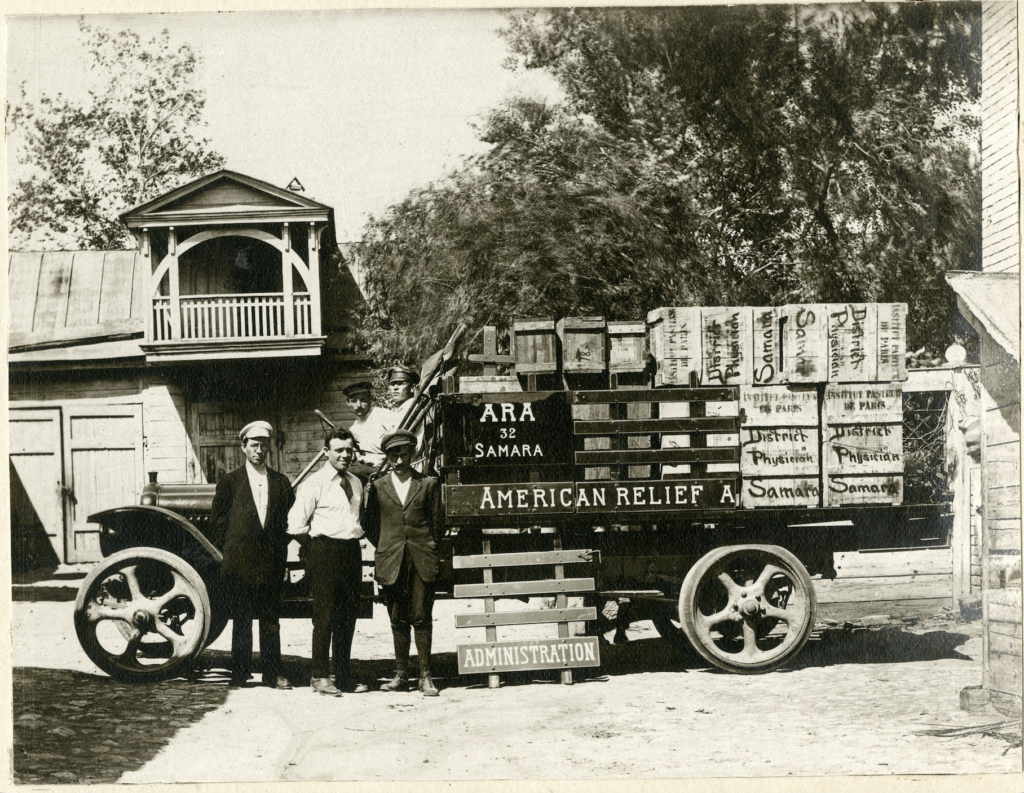
Does the story of the ARA’s efforts offer lessons for today in terms of providing humanitarian aid in hostile political contexts?
Herbert Hoover’s ARA intervened in a politically hostile environment in Soviet Russia. Hoover was staunchly anti-Communist and, like Henry Ford, was considered the embodiment of American capitalism. The American relief workers had no love for the Soviet regime and its officials, while Soviet officials were very nervous about allowing an American humanitarian relief agency to enter their country and operate in relative freedom.
Hoover insisted that the American aid workers, in collaboration with local citizens, should decide how to distribute the relief. Independence of action, Hoover maintained, was something the American public demanded in exchange for its support. Once the Soviet government agreed to allow the ARA into the country, it could not influence the choice of American beneficiaries—although at times it certainly tried, especially at the local level. I think this is something you’d have to insist on—that the government stand back and allow the aid providers to work with the local citizens to determine where aid is most needed and to identify those truly in need of assistance. That might be a non-starter in many places today.
What would have happened in Soviet Russia if Hoover and the ARA had not intervened because of political concerns? Millions more people would have died and nobody would have looked good. Nobody would have won. Hoover’s idea was that if people are starving, they should be fed—first and foremost, the children.
